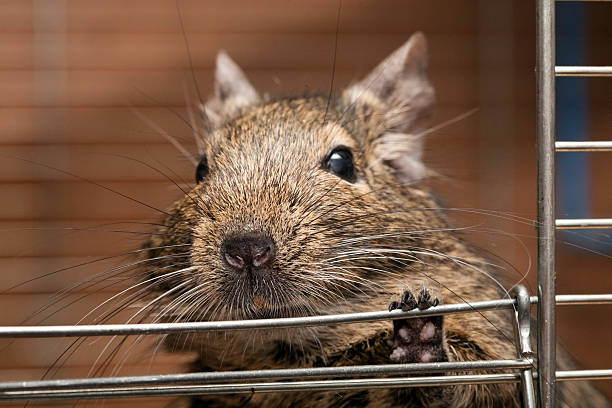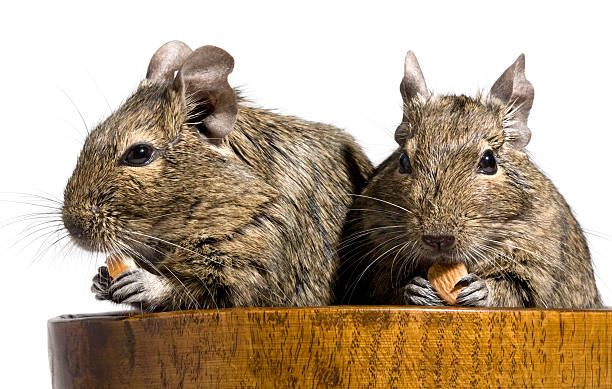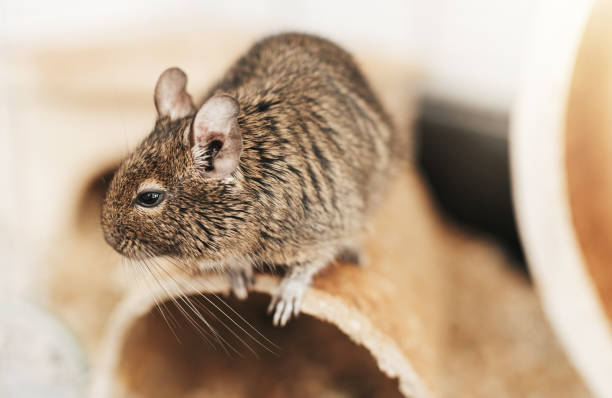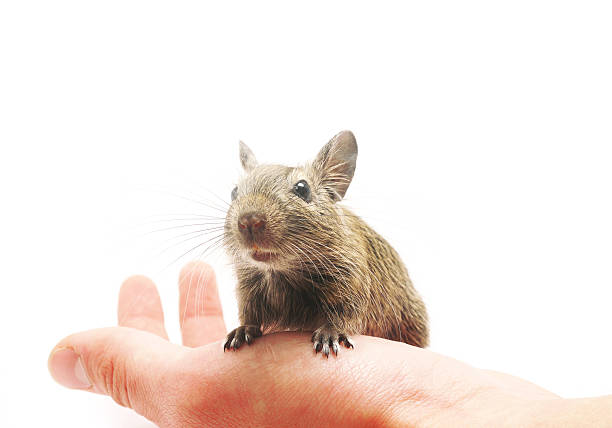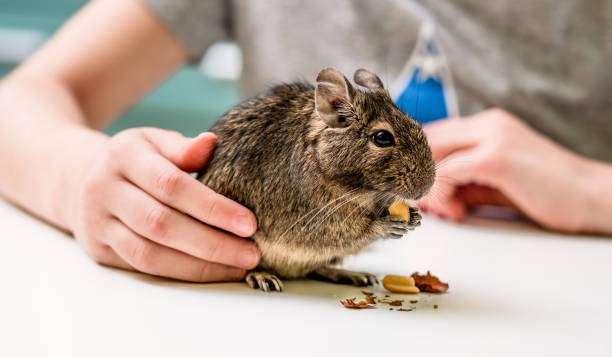Discovering Degu: 10 Fascinating Fun Facts
This post contains affiliate links. This means I will make a commission at no extra cost to you should you click through and make a purchase. Read the full disclosure here.
Welcome to an exciting exploration of the charming world of degus! These delightful rodents have captured the hearts of many with their intriguing behaviors and unique qualities. While you may already be familiar with some aspects of degu life, get ready to uncover a whole new realm of fun and lesser-known facts about these captivating creatures.
Degus, scientifically known as Octodon degus, originates from the rocky landscapes of Chile and are a part of the Octodontidae family. Their sociable and curious nature makes them fascinating companions for those who appreciate their engaging behaviors. As we journey through this blog post, you’ll discover 10 captivating fun facts that shed light on the astonishing lives of degus, showcasing their social interactions, physical abilities, communication skills, and much more.
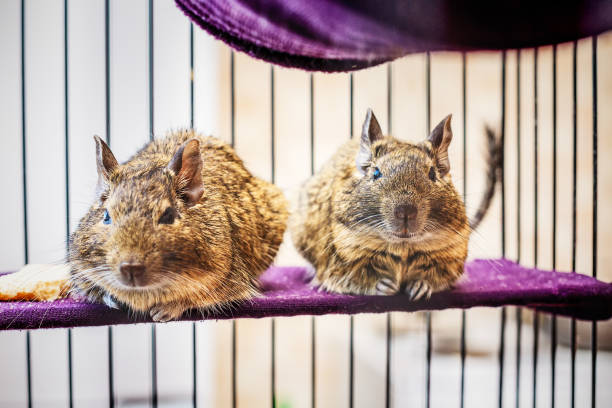
1. Social Butterflies of the Rodent World
Degus are not your typical solitary rodents; they thrive on companionship and social interactions. In their natural habitat, these rodents form close-knit family groups, known as colonies, that play a crucial role in their survival and well-being. Living in these groups enables degus to establish hierarchies, groom each other, and communicate through a diverse range of vocalizations.
Within a degu colony, you’ll witness various interactions that mirror the complexities of a miniature society. They engage in mutual grooming, a behavior that reinforces social bonds and helps maintain their fur’s cleanliness. Additionally, they use vocalizations to convey messages and express emotions. From friendly chirps to more assertive squeaks, these vocal cues play a vital role in their social dynamics.
As a degu owner, recognizing their social nature is essential for their happiness and mental health. If you’re considering adding degus to your family, it’s recommended to keep them in pairs or small groups to provide the companionship they thrive upon. By appreciating their intricate social behaviors, you’re opening the door to understanding the fascinating world of degu interactions.

2. Acrobats in Action
When it comes to agility and acrobatics, degus are true stars of the rodent world. These small creatures possess an astonishing ability to climb, jump, and navigate their surroundings with grace and precision. Their remarkable agility is not only entertaining to observe but also serves practical purposes in their natural habitat.
One of the standout features aiding their acrobatic prowess is their long and bushy tail, which acts as a counterbalance while they navigate complex environments. Whether they’re scaling branches, leaping between surfaces, or exploring their cage, their tail helps maintain stability, preventing falls and ensuring graceful landings.
Next time you watch your degus in action, take note of their impressive climbing skills. Their innate ability to maneuver through various terrains is a testament to their adaptability and evolutionary traits. Providing a multi-level cage with platforms and climbing opportunities mimics their natural environment, encouraging them to exhibit their acrobatic talents.
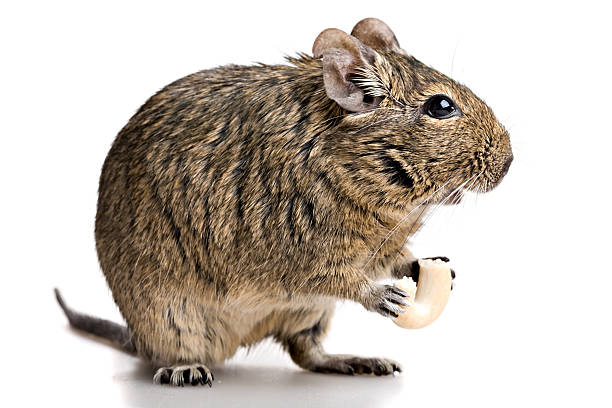
3. Master Mimics: Vocalizations and Communication
Degus are not just acrobats; they’re also skilled communicators with a wide range of vocalizations that serve as their language. These vocal cues allow them to express a variety of emotions, convey information, and establish their social hierarchy within a group. As a degu owner, understanding their vocal repertoire can offer insights into their interactions and behaviors.
Listen closely, and you’ll hear degus emit an array of sounds. From high-pitched whistles that indicate excitement to low grunts that can signal displeasure, their vocalizations reflect their emotions and intentions. They might use gentle chirps during grooming sessions to reinforce social bonds or emit loud squeaks to establish dominance.
Observing their vocal exchanges provides a window into their social dynamics, helping you understand who’s asserting their authority or seeking companionship. Over time, you’ll become adept at deciphering their cues and responses, deepening your connection with these expressive creatures.
By recognizing the significance of their vocalizations, you’ll gain a richer understanding of degu communication.
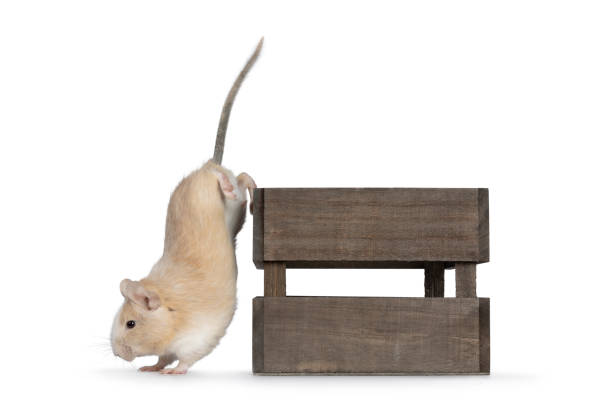
4. Tail Tales: The Multifunctional Degu Tail
The tails of degus are more than just adorable appendages – they’re versatile tools that play a crucial role in their daily lives. These long and bushy tails aren’t just for aesthetics; they serve multiple functions that contribute to the degus’ overall survival and interactions within their social groups.
One of the primary roles of a degu’s tail is to aid in balance. As these rodents navigate their intricate environments, their tails act as counterbalances, helping them maintain stability during leaps and climbs. This remarkable adaptation ensures their agile movements and graceful landings, even in challenging terrains.
Additionally, degus use their tails as communication tools. During social interactions, they might engage in tail-waving behaviors. This involves rapidly moving their tails from side to side, which serves as a form of communication within their group. This behavior, often accompanied by vocalizations, helps maintain social cohesion and harmony.
As you observe your degus’ interactions and movements, take a moment to appreciate the significance of their tails. These remarkable structures are a testament to their adaptability and the intricate ways in which they’ve evolved to navigate their environment and communicate with one another.

5. Nature’s Architects: Burrowing Behaviors
A fascinating aspect of degu behavior lies in their innate talent for excavation and burrowing. In their natural habitat, these rodents create elaborate tunnel systems that serve as their homes, protection from predators, and places to store food. This behavior showcases their remarkable adaptability to their rocky environments.
Degus are meticulous architects, using their strong claws and teeth to dig intricate tunnels that can extend several meters into the ground. These tunnel systems feature various chambers for different purposes, including nesting, food storage, and even latrine areas to keep their living spaces clean.
When you observe your degus burrowing into their bedding or creating little hideaways in their enclosure, you’re witnessing a behavior deeply ingrained in their nature. Providing them with materials like dust-free substrate and nesting materials mimics their natural habitat and satisfies their instinctual drive to dig and burrow.
By understanding and respecting their burrowing behaviors, you’re offering them an environment that aligns with their natural inclinations.
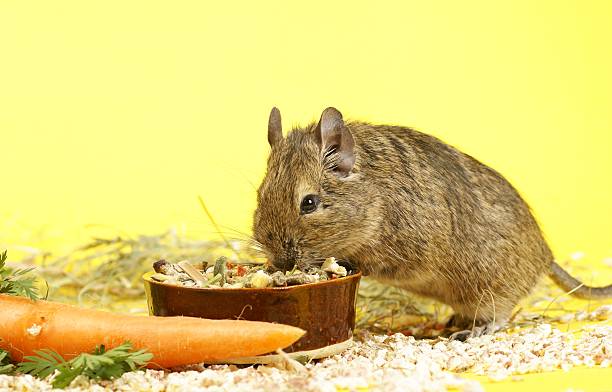
6. Curious Connoisseurs of Food
Degus are more than just energetic and social creatures – they’re also curious food enthusiasts! These rodents have a natural penchant for exploring a wide variety of foods, which plays a significant role in their diet and overall well-being.
In the wild, degus are herbivores with diets consisting of a range of plant materials such as leaves, seeds, and fruits. This diverse diet is reflected in their keen interest in exploring different food items. As a degu owner, you’ll likely notice their enthusiasm as they inspect, nibble, and taste-test various treats and vegetables.
Their interest in new foods goes beyond mere curiosity. Providing them with a variety of fresh veggies, herbs, and occasional fruit treats not only keeps them mentally stimulated but also ensures they receive a well-rounded and nutritionally balanced diet. Remember to introduce new foods gradually to prevent digestive upset and observe their preferences.
Observing your degus’ enthusiastic approach to food is a joyful experience. Embrace their inquisitive nature by offering them a selection of safe and nutritious options. As we progress through this exploration of degu fun facts, you’ll continue to uncover more of their charming and endearing behaviors. Stay tuned for more insights into their delightful world!
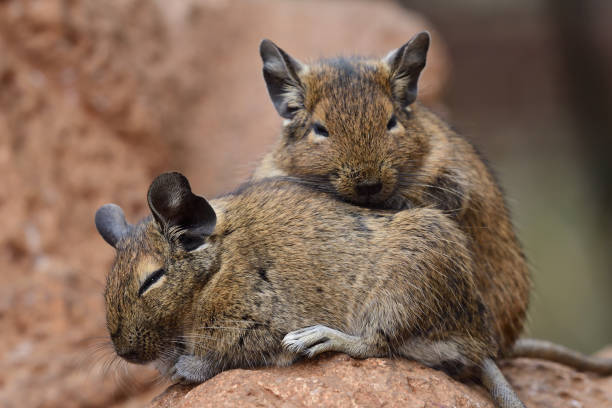
7. Grooming Rituals: A Bonding Experience
Degus aren’t just social animals – they’re also diligent groomers who engage in mutual grooming as a form of bonding and social interaction. This behavior is not only practical for maintaining hygiene but also plays a significant role in strengthening relationships within their groups.
Mutual grooming involves one degu grooming another, often focusing on hard-to-reach areas like the head, neck, and back. This intimate interaction fosters trust and camaraderie among group members, solidifying their social bonds. It’s not uncommon to see degus grooming each other’s fur, whiskers and even assisting with cleaning those tricky ears.
As a degu owner, observing this behavior is heartwarming and highlights the close-knit nature of their interactions. While you might not be able to participate directly in their grooming rituals, providing a clean and comfortable environment encourages their natural behaviors.
While grooming each other is a group activity, degus also take pride in their own personal grooming routines. They meticulously clean their fur and whiskers, showcasing their commitment to cleanliness and self-care. By recognizing the significance of grooming in their social lives, you’re gaining a deeper understanding of the intricate dynamics that shape degu behavior.
8. Natural Sun Worshippers

Degus are creatures of habit, and one of their endearing habits is sunbathing. These rodents have a natural inclination to bask in the warmth of the sun’s rays, showcasing their preference for sunny spots in both their natural habitat and their enclosures.
You might observe your degus stretching out and exposing their bellies to the sun. This behavior, known as dorsosacral scent marking, serves multiple purposes. Not only does it help regulate their body temperature, but it also leaves behind their scent as a form of communication to other degus in the area.
In the wild, degus make use of the sun’s warmth to help thermoregulate their bodies and reduce moisture after rainfall. Providing your degus with a well-lit area in their enclosure allows them to engage in this natural behavior, which contributes to their overall well-being and comfort.
Understanding their love for soaking up the sun offers insights into their natural behaviors and instincts. As we continue to uncover more fascinating aspects of degu life, you’ll gain a deeper appreciation for these remarkable rodents and their unique traits.
9. Memory Marvels: Their Navigational Skills

Degus are not only charming and social creatures; they’re also known for their impressive navigational skills. These rodents have an uncanny ability to remember intricate pathways and locations within their environments, making them excellent explorers and foragers.
In their natural habitat, degus roam through complex terrain filled with nooks, crannies, and potential hiding spots. Their sharp memory helps them navigate these challenging landscapes efficiently, allowing them to find food sources, escape from predators, and return to their burrows without losing their way.
As a degu owner, you might notice their keen sense of direction as they confidently explore their enclosure, remember hiding spots, and swiftly move through various levels and structures. Offering them an enriched environment with tunnels, platforms, and climbing opportunities allows them to engage in their natural behaviors while showcasing their navigational prowess.
By recognizing their remarkable memory and navigational skills, you’re gaining insight into their intelligence and adaptability.

10. Whisker Wonders: Sensitive Sensory Organs
Whiskers, scientifically known as vibrissae, are incredible sensory organs found on various animals, including degus. These specialized hairs play a crucial role in helping degus navigate their environment, communicate, and understand the world around them.
Degus possess vibrissae on their faces, particularly around their snouts. These whiskers are highly sensitive to touch and vibrations, allowing degus to gather information about their surroundings and detect subtle changes in their environment. They use their whiskers to explore objects, navigate through tight spaces, and even gauge the dimensions of openings.
While observing your degus, you might notice them extending their whiskers when they’re exploring or investigating new objects. This behavior showcases their reliance on this remarkable sensory tool to gather information about their environment and make informed decisions.
Providing your degus with an enriched environment that encourages exploration and interaction allows them to fully utilize their whiskers as they engage in their natural behaviors. By recognizing the importance of these sensitive sensory organs, you’re gaining insight into the intricate adaptations that enable degus to thrive in their habitats.
As we conclude this exploration of degu fun facts, we hope you’ve gained a deeper appreciation for these charming and remarkable rodents. Their unique behaviors, communication methods, and adaptations contribute to making Degus truly special companions. Thank you for joining us on this journey through the captivating world of degus!




